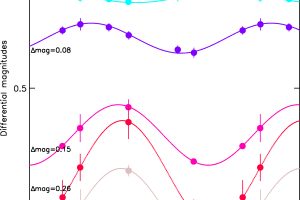The first study in the framework of GIARPS rules out the existence of a hot Jupiter. The study: “Multi-band high resolution spectroscopy rules out the hot Jupiter BD+20 1790b. First data from the GIARPS Commissioning” of I. Carleo (INAF – OAPd) recently published on A&A

Most of the exoplanets identified so far have been discovered by using two techniques: transits and radial velocity. In particular, radial velocity method consists in detecting the oscillations of stars around the center of mass common with their planetary systems by measuring periodic doppler shifts in high-resolution spectra. The main difficulty with this technique is the fact that stellar activity, mainly the presence of photospheric spots and chromospheric active regions, may produce a signal that mimics the presence of an exoplanet.
It may happen, thus, that the presence of an exoplanet orbiting a given star can not be confirmed until the possibility that the observed signal is produced by stellar activity is definitely discarded. The most efficient way to do this is by observing radial velocity signals simultaneously in optical and infrared. In fact, stellar activity signals are larger in optical than in infrared, while those due to the presence of exoplanets do not depend on the wavelength. This is the strategy adopted by the project GIARPS, which combines simultaneous radial velocity measurements with the high-resolution spectrograph GIANO-B and HARPS-N mounted on the Telescopio Nazionale Galileo.
In the first study produced in the framework of GIARPS project, “Multi-band high resolution spectroscopy rules out the hot Jupiter BD+20 1790b. First data from the GIARPS Commissioning” of I. Carleo (Universita’ degli Studi di Padova e INAF – Osservatorio Astronomico di Padova), recently published on Astronomy & Astrophysics with the collaboration of the astronomers G. Micela, E. Gonzalez-Alvarez e J. Maldonado of INAF – Osservatorio Astronomico di Palermo, the presence of a hot Jupiter around the star V429 Gem (BD+20 1790) with spectral class K5Ve is ruled out on the basis of the comparison of radial velocity amplitude measured in optical and infrared. The authors, in fact, have found an amplitude of 1900 m/sec in optical and 440 m/sec in infrared, which is a difference due to stellar activity, known to be intense in this star.
The figure (link) shows the light curve of V429 Gem observed in different bands.
